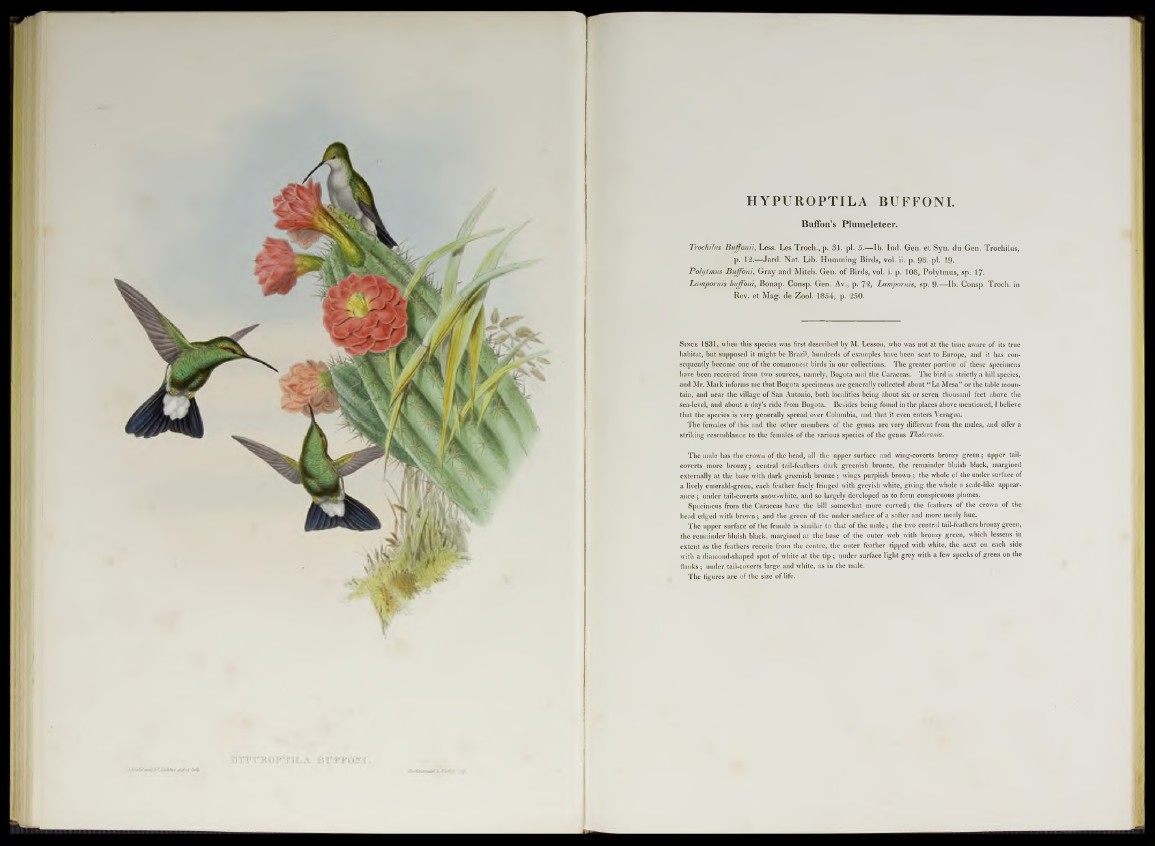
HYPUROPTILA BUFFONI.
Buffon’s Plumeleteer.
Trockilus Biiffonii, Less. Les Troch., p. 31. pl. 5.—Ib. Ind. Gen. et Syn. du Gen. Trochilus,
p. 12.—Jard. Nat. Lib. Humming Birds, vol. ii. p. 98. pl. 19.
Polytmus Buffoni, Gray and Mitch. Gen. of Birds, vol. i. p. 108, Polytmus, sp. 17.
Lampornis buffoni, Bonap. Consp. Gen. Av., p. 72, Lampornis, sp. 9-—Ib. Consp. Troch. in
Rev. et Mag. de Zool. 1854, p. 250.
S ince 1831, when this species was first described by M. Lesson, who was not at the time aware of its true
habitat, bat supposed it might be Brazil, hundreds of examples have been sent to Europe, and it has con-
sequently become one of the commonest birds in our collections. The greater portion of these specimens
have been received from two sources, namely, Bogota and the Caraccas. The bird is strictly a bill species,
and Mr. Mark informs me that Bogota specimens are generally collected about “ La Mesa” or the table moun-
tain, and near the village of San Antonio, both localities being about six or seven thousand feet above the
sea-level, and about a day’s ride from Bogota. Besides being found in the places above mentioned, I believe
that the species is very generally spread over Columbia, and that it even enters Veragua.
The females of this and the other members of the genus are very different from the males, and offer a
striking rcscmblauce to the females of the various species of the genus Thalurania.
The male has the crown of the head, all the upper surface and wing-coverts bronzy green; upper tail-
coverts more bronzy; central tail-feathers dark greenish bronze, the remainder bluish black, margined
externally at the base with dark greenish bronze ; wings purplish brown ; the whole of the under surface of
a lively emerald-green, each feather finely fringed with greyish white, giving the whole a scale-like appear-
ance ; under tail-coverts snow-white, and so largely developed as to form conspicuous plumes.
Specimens from the Caraccas have the bill somewhat more curved; the feathers of the crown of the
head edged with brown; and the green of the under surface of a softer and more mealy hue.
The upper surface of the female is similar to that of the male; the two central tail-feathers bronzy green,
the remainder bluish black, margined at the base of the outer web with bronzy green, which lessens in
extent as the feathers recede from the centre, the outer feather tipped with white, the next on each side
with a diamond-shaped spot of white at the tip ; under surface light grey with a few specks of green on the
flanks; under tail-coverts large and white, as in the male.
The figures are of the size of life.